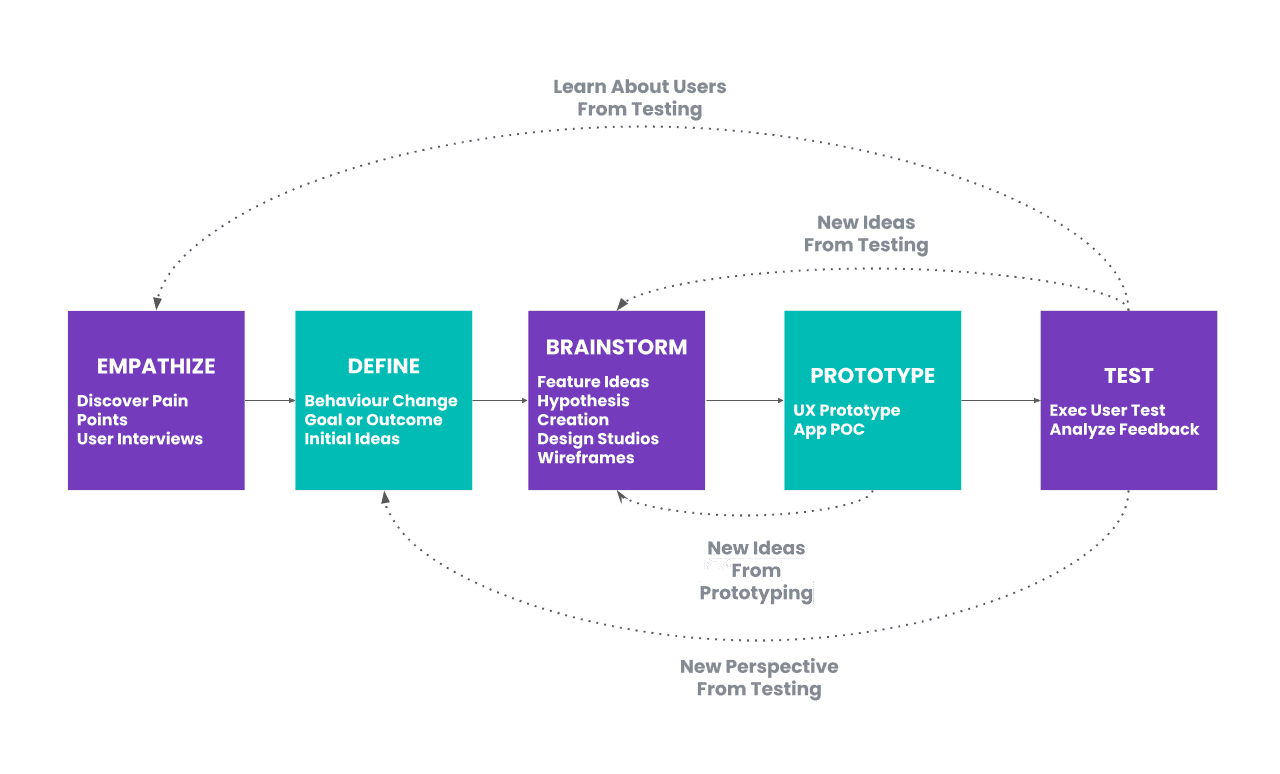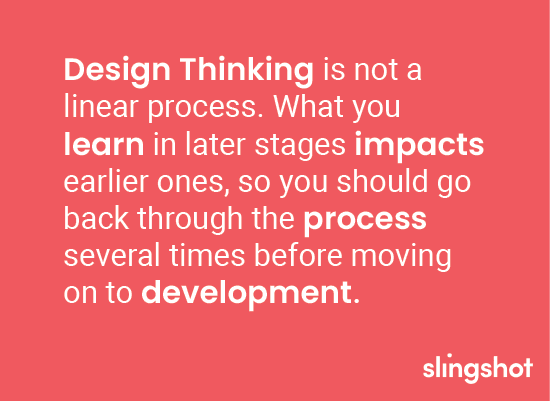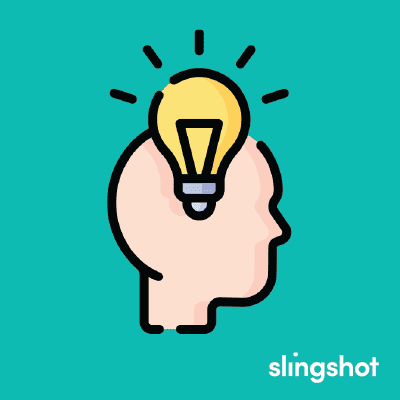In today’s world, people are drowning in how many tech products they use. For example, it’s estimated that most people have around 80 apps on their phones, with most people only using 9 to 10 per day.
So how can you be sure your tech product will stand out in the gargantuan sea of technology? Innovation, of course! But it’s harder than just saying you’re going to innovate; you have to have a concrete plan to ensure your product is innovative.
Enter, Design Thinking: a process we use here at Slingshot to ensure the products we build are effective and intuitive for users.
In today’s world, people are drowning in how many tech products they use. For example, it’s estimated that most people have around 80 apps on their phones, with most people only using 9 to 10 per day.
So how can you be sure your tech product will stand out in the gargantuan sea of technology? Innovation, of course! But it’s harder than just saying you’re going to innovate; you have to have a concrete plan to ensure your product is innovative.
Enter, Design Thinking: a process we use here at Slingshot to ensure the products we build are effective and intuitive for users.
Enter, Design Thinking: a process we use here at Slingshot to ensure the products we build are effective and intuitive for users.
What is design thinking, and how does it help drive innovation? Step into our world and learn why a human-centric approach is crucial for success.
Summary
- Design thinking is a problem-solving approach focused on understanding user needs and developing products to meet those needs.
- The design thinking process consists of five steps: Empathize, Define, Brainstorm, Prototype, and Test.
- Design thinking drives innovation through user-centric problem identification and unique solution creation, facilitated by iterative testing, collaborative teamwork, a focus on user-friendly products that address real-world problems, and an embrace of failure as a catalyst for continuous learning and innovation.
What is Design Thinking?
Before utilizing design thinking, we have to know what it is! The concept of Design Thinking’s been around since the 1960s but wasn’t brought into the business innovation world until the early 2000s.
Design thinking is a problem-solving approach that focuses on understanding your users’ needs and then developing your product to meet those needs. Another way to describe it is as a human-centered approach, with the main goal to build an intuitive and user-friendly product that addresses the needs of your target audience.
But how do we do that? Check out this diagram to see what the design thinking process is:


Whew, that’s a tad bit complicated! If you’re not a visual learner, let’s boil this down. There are 5 main steps to design thinking: Empathize, Define, Brainstorm, Prototype, and Test. You start out by trying to understand your user’s needs and pain points. This can be done by external observation, interviews, or surveys.
Once you have a foundation of understanding, you move on to discuss the initial ideas. What is the goal? What are we trying to get people to do? The answers to these questions will help in the next step: Brainstorming. Here, you’ll come up with hypotheses for what should be built and the general design layout.
Now it’s time to ‘design’ how most people think of it: you’ll create a prototype that looks and feels like an actual product. Branding, visuals, and content, oh my! The goal of the prototype is to create something that can be used in the final step of testing. Here, you’ll have users try to navigate and use the prototype as if it were a real product.
The most important part? Design Thinking is not a linear process. All the lines and arrows show how what you learn in later stages impacts earlier ones, and that you should go back through several times before moving on to development.

How to Use Design Thinking to Drive Innovation
Now to tackle the reason you’re here: how can using a design thinking approach help you to build more innovative products? Here are 5 ways to get outside that box:
You Need Their Needs
Design thinking’s first step is to empathize with your user: what are their needs and desires? Instead of building a product to solve a potential problem, you can identify the exact problems users are having and create a potentially never-before-seen solution for them.
Iterate Before It’s Too Late
We mentioned it already, but design thinking is a non-linear process that should be iterated on multiple times before a project is done. This allows your team to test and refine ideas quickly and without a significant investment of time or resources. Why not test that idea; you never know if it could be the reason your project becomes a success.
Collaborate, It Takes a Village
Design thinking is a complex approach; there’s a very small chance one person on your team will have all the necessary skills. While that sounds like a bad thing, it’s actually one of the reasons design thinking fosters innovation: you’ll have a group of people working together to solve this puzzle. Collaboration means different perspectives and expertise, which can lead to innovative solutions that wouldn’t be possible with just one person.
Human at the Core
If you want to get users to, well, use your product, it’s going to need to be easy to understand. Design thinking puts the focus on solving real-world problems. By designing solutions that people actually want and need, you can drive innovation and create products that stand out in the market.

Grow, Grow, Grow
It’s hard to build innovative products when the consequences of failure are too scary. What if you damage your reputation, or even lose your job? In design thinking, ‘failure’ is built into the process; you’re going to go back and continue to iterate on your ideas. When you cultivate a culture that values experimentation and risk-taking, you can view setbacks as learning opportunities and use them to drive further innovation.
Conclusion
Design thinking is a powerful approach that can drive innovation in your software development projects. By empathizing with your users, defining the problem, brainstorming ideas, prototyping, and testing, you can create user-centric solutions that address real needs and drive innovation.
Design thinking encourages collaboration, iteration, and a focus on the human experience, which leads to more innovative and user-friendly products.
Don’t let your app be another wave in the ocean; give your users a lifejacket with design thinking! By embracing this iterative and user-centered approach, you can unlock the full potential of your projects and create products that truly stand out in the market.




